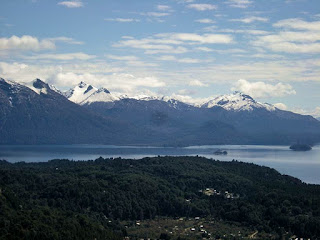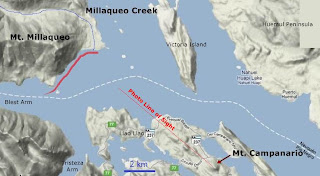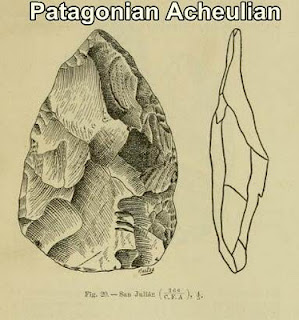Image of Mapuche “Lightning Stones” or “Toki Kurá”. From [8]
The late Rodolfo Casamiquela wrote his En pos del Gualicho (“In search of the Gualicho”) in between 1975 and 1984, and published it (Eudeba, Fondo Editorial Rionegrino) in 1988.
It is in his own words "...a continuous juxtaposition of new topics, that rose from the central theme... the thing gets complicated because both the original core and the addenda were corrected and interpolated more than once... over a period of ten years".
The book is quite complicated to read as it is a blend of interconnected topics, where Casamiquela jumps from one to the next, branches out along a path, and, once he gets back to the fork, then forgets to carry on with the original thread, leaving the reader waiting for more information! It includes many complex etymological comments on the Mapuche and Tehuelche languages, which explain some things but, regrettably obscure others. If you are not into Patagonian natives and their myths, you will surely fall asleep reading it!.
Gualicho
However it is an interesting source for those interested in the Patagonian evil creature "par excellence", the Gualicho. It is a pan-Patagonian myth, a monster, night creature, child kidnapper, a creature that had to be appeased so that it took its evil powers somewhere else.
From Patagonia the myth spread out through Southern Chile and the Pampas, borne on the hordes of Mapuche and Mapuche language speaking Puelches, into Buenos Aires and Uruguay. The myth still exists today and is a common household word (for instance: lovers are often said to be "engualichados" -bewitched) in Chile, Argentina and Uruguay.
The actual word “Gualicho” is Mapuche but its origin can be traced to the Tehuelche language for it is actually a Tehuelche myth. There are several Tehuelche words for this monster. One of its many names is Ajchüm, another is Elëngassën. The Mapuche blended their own “monster myth” of Kollón with Gualicho.
This is a genuine Patagonian myth. But, what is this creature supposed to be?
In my book, I mention the myth, and note that it has two different personifications, one human-like, the other, an animal:
As described by Claraz and Moreno, the Elëngassën at Segunda Angostura, excluding its armadillo-like shell, had several human traits: it had the face of a man, it could vocalize and insult, furthermore, it could throw stones, something no glyptodon or any animal other than a human or a hominid could do. This was no glyptodon.
In addition, Moreno likens it to the Huitranalhue (see chapter V), which was a being described both as a man and as an animal. Mythical Carcancho also shares this dual human-animal nature. It is very probable that Elëngassën and several varieties of Carcancho were some sort of animal while Huitranalhue and the Segunda Angostura cave creature were some kind of wild man. [4]
In today's post I will take some of the information given by Casamiquela in his book and focus on the "creature" behind the myth, the man-like creature (not the animal) and see if it sheds any light on a possible hominid origin for the myth.
Ajchüm
Casamiquela, reports that his native Tehuelche informant, José Qulchamal, told him that the creature was also known as ósüne, meaning "the ugly one". Below is a transcription of Casamiquela's interview:
"He had a hide like a guanaco [guanaco = relative of the llama and vicuña] , stole children and was hunchbacked... He was not people, he may have looked like people, but he was not people... He, who robbed children, yes... He was a male ... /what was his shape? or, had he four or two paws?/ no, no, he did not have paws, he was the same as a person... a very unsociable person / why unsociable?/ Because he had lived in those cliffs over there ... he would throw stones at you... and I have heard that thing cry out. /So the Ajchüm would still be alive/ yes, still.... that man does not have clothes like we have, seems like he was, or carries leather, of guanaco hide /Ah, he has a thick hide?/ "A thick hide I do not know, but the same color as the guanaco. .. he took [the children] and of course, killed them..." [1]
Called Kollón by the Mapuche Carmen Nahueltripay, a mix of Tehuelche and Mapuche, she said that Kollón "was like people, very big... its face very long, it has hair, speaks like people but is not tame".[2]
Another native informant, Liboria Crespo said that "Kollón was the ancestor of the [Tehuelche] race" [2].
What is more, these creatures have lived until relatively recent time, another native, Margarita Manquilef, of Ramos Mexía, Río Negro Province, reported that "until recently there was an "kollón" couple living at Garacán lagoon, towards Somuncurá in the Tambelén, Tapiluque area of Río Negro. They could be seen on a mountain top, on the prairie, of stone, with a child on their shoulders. They lived in a cave. One died and its bones remained..."[2]
Mariano Huala, from Alto Río Senguerr, in Chubut province, said that "his body was the same as that of a Christian [i.e. a human being]. Only his skull and his face was different... bigger... he lived in the Andean Cordillera, in the highest places" [2]
What is it?
Let’s check its main features:
- Man-like (“a person but not a person”)
- A hunch-backed person
- Lived in cliffs, in the highest mountains
- Unsociable, stole children, mated (lived in pairs and carried child on shoulders)
- Different face (longer) and skull
- Hairy, wore a hide or its hair was like the fur of a guanaco (light brown, soft and fluffy).
- Vocalized (nobody mentions “speaking”).
- Threw stones
- Ancestor of the Tehuelche people (a primitive human being?)
The interesting part is the stone axe. Which may be an Acheulean axe!
The axe
In a previous post I mention Felix Oute’s article which reported an Acheulean-style handaxe in Patagonia and hinted that it may be the work of pre-sapiens humans. In his book, Casamiquela mentions [3] a Tehuelche phrase regarding Gualicho: "tauk ka ülüngásüm a újüch". That is, the “Axe of the Gualicho”.
Casamiquela says that this "axe of the Kollón" is also known by its Mapuche name ("toki" = axe). He drops the thread there but mentions on pp. 24 that the creature “owns a certain stone “axe”, he makes no further refrence to stone axes beyond some remarks on the “engraved stones” (placas grabadas) on pp. 73, which are not axes but fragile pieces of slate, engraved with lines and drawings. Their real purpose is unknown.
So, it is quite likely that the Gualicho is a primitive human (either Neanderthal or even H. erectus, making stone tools and living in secluded areas.
What follows deals with the Mapuche stone axes, which in my opinion have nothing to do with the Gualicho myth and Casamiquela’s attempt to blend them is mistaken.
The Mapuche stone axe, Toki-Cura
The “toki” or “toqui” (both kinds of spelling are valid) is part of the Mapuche (the Chilean Mapuche) culture.
According to Diego de Rosales, who wrote one of the first History’s of Chile’s in the late 1600s, there was a Mapuche “official”known as the “General Toqui”, (who got his name from? Or gave it to? The “toqui” ceremonial axes. He wrote that:
General Toquis are justices and just like the Romans used to carry ahead of them some axes and staffs that they called faces et falaces, these [natives] carry as a symbol, some axes , not of iron but of flint, with a handle fixed to them, like the consular faces, symbols of their dignity” [7]
They were military authorities and used these axes in their councils with other General Toquis. The axes were ceremonial, made of black stone, sometimes meteorites were used for this purpose (having fallen from heaven they were supposedly divine and conferred power to its user). They have also been described as [6] “a polished sub-cylindric neolithic axe”.
Trivia
1. By the way, [5] the Mapuche word toki, is taken as a possible link between the Polynesian cultures and the Mapuche, since the same word is used in Eastern Polynesian (Easter Island uses the word toki and the Hawaians ko’i pohaku) for “stone axe”. Coincidence or pre-Hispanic contacts?
2. The stone axe is also known as toquichen and Toqui curá (Curá is their word for “stone”) so it means “stone axe”.
There is also another name for the axe: Pillán Toqui, Pillán’s axe.
This last name is associated to their god Pillán, associated to volcanos and lightning / thunder, and is therefore very similar to the Roman god Jupiter and the Scandinavian Thor, both of which are linked to lightning.
Furthermore, the Mapuche axe is also known as “Lightining stone” and said to fall from the skies during storms (it also points at the “meteorite” stone used to make some of these axes). [6]
I am not implying that the Romans or Vikings transmitted their myths to the ancient Mapuches, I just want to point out how some beliefs appear in a recurrent manner over the years among different people.
Interestingly, an online source [8] says that “the lightning stones were NOT prehistoric axes but a product of nature. Lightning strikes and it penetrates the soil at high temperatures melting minerals on the way and dragging them to a considerable depth. These, when they cool down have the shape of an axe or a cone”. It mentions Darwin’s findings (read about it in his Beagle Voyage book) on a beach (in Uruguay) , of glass rods caused by lightning.
Sources
[1] Rodolfo Casamiquela, (1988). En pos del Gualicho. Eudeba, Fondo Editorial Rionegrino. pp. 84
[2] Op. Cit. pp.12-14
[3] Op.Cit. pp. 13
[4] Whittall, Austin. In print. Patagonian monsters : a guide to its giants, dwarves, lake creatures and mythical beasts Buenos Aires : Zagier & Urruty Publicaciones, 2011.
[5] Adolphe Wurm, Peter Mühlhäusler, Darrell T. Tryon, (1996). Atlas of languages of intercultural communication in the Pacific, Asia and the Americas. Walter de Gruyter, pp 1334.
[6] Oscar Barreto. (1996). Fenomenología de la religiosidad mapuche Editorial Abya Yala. pp 16.
[7] De Rosales Diego, (1674) Historia General del Reyno de Chilepp. 178 (Ed. 1877 Valparaiso)
[8] Tradición Espiritual Aborigen, Introducción de F. Schuon al libro
"La Pipa Sagrada" de Hehaka Sapa
Patagonian Monsters - Cryptozoology, Myths & legends in Patagonia2011 International Year of Forests Copyright 2009-2011 by Austin Whittall ©

























